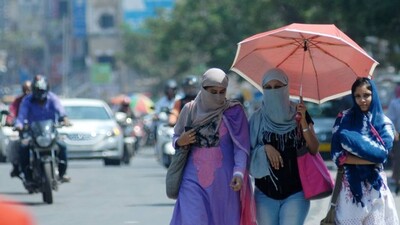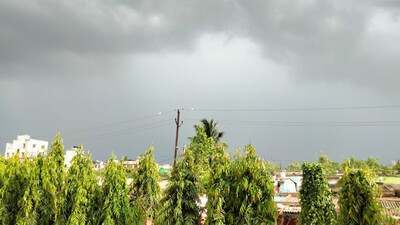Recommended Stories
With the Arabian Sea having given birth to extremely severe cyclone Tauktae , hotter Bay of Bengal is poised to give birth to a cyclonic system by the end of May.
Whenever the Bay brews up a cyclone, a chill runs down the spine of Odisha. It’s so because, the Bay had given birth to 26 of world’s 30 ferocious cyclonic systems.
The worry for Odisha is, the State had borne the brunt of nearly 400 cyclones during the periodof 1891 –2020,which is nearly 35 per cent of the total cyclones the Bay had seeded during the above-mentioned period.
Cyclone Yaas LIVE Updates: All you need to know
The double anxiety for the State over the impending cyclone threat this time is, it has been waging a war with the ferocious Covid-19 second wave.
As per three reputed weather models – US-GSF, ECMWF and CGEPS (MME) of Indian Institute of Tropical Metrology (IITM), the Bay of Bengal will churn a low pressure area in the north-east quadrant of the BoB.
Also Read
The model predictions show that the low pressure system will grow up to become a cyclone between May 23 and June 1.
For the citizens of Odisha, the forecast has only revived the ghastly memories of the last two consecutive years.
The Statehad witnessed the fury of cyclones - Fani and Amphan - during the peaksummer month of May in 2019 and 2020.
Given such a recent historical context, will the probable cyclonic system take an aim at Odisha?
Will 2021 turn another cyclonic year for the State?
Will The Forecast Turn TRUE?
Though it’s too early to give any clear cut prediction, the significant note here is even the IMD’s extended range forecast has alsohoisted a probability ofcyclonegenesis in the last week of May.
“In the last week of May, there is a probability (11-33%) of cyclonegenesis in the east central and adjoining north east Bay of Bengal,” says the IMD forecast.
Are BOB Conditions Ripe for Birth of A Cyclone?
As per the data available with Indian National Centre for Ocean Information Services (INCOIS), while the sea Surface Temperature (SST) for the whole of BoB is predicted to remain at around 30degree Celsius, the SST in the probable LOPAR area has beenpredicted to remainhigh at around 32 deg C.
Moreover, the Madden Julian Oscillation (MJO), which is in the weak phase now, will enter into the strong phase from May 23.
Moreover, IITM (Indian Institute of Tropical Meteorology) MJO analysis says the coming phase of MJO will aid convective activity and may aid the probable low pressure to gain strength. The rain bearing phase of MJO will remain till June 2.
As the LOPAR will take shape during the period of May 23-29, the strong phase of MJO till June 2 may aid the cyclonegenesis process, says the analysis.
Will Season's First Cyclone in Bay of Bengal Take Shape?
As per US-GFSmodel data available, a cyclonic circulation will come into existence on around May 23.
And a LOPAR will come into shape in next 48 hours. The GFS model predict the central pressure of the system to remain at around 981millibar – which means the probable cyclone to grow into the category of Extremely Severe Cyclone storm (ESCS).
As of now there has been a rare unanimity among all the models - IITM's (India) CGEPS (Climate Forecast System-based Grand Ensemble Prediction System), IMD, US-GFS (Global Forecast System) and ECMWF (European Centre for Medium Range Weather Forecast).
All the models predictaprobability of cyclonegenesisin BoB in the last week of May.
The Model Predictions
As per the US-GFS model, the low pressure area willcome into existence by May 23 in the north east BOB.
The prediction says the system will intensify there and take a curve towardsnorth coastal Odisha and West Bengal.
Similarly, while ECMWF predicts cyclonegenesis in the last week of May, it also predict that the system will grow up to become a cyclone.
Predicting on the lines of GFS, the model of this top-rated global met agency says the system will grow to an extremely severe cyclonic storm.
ECMWF predicts with over 70 per cent probability that the system will chart it’s course towards Odisha and make landfall on May 27 between Puri – Paradip.
The CGEPS model of IITM, a peer Indian agency, also assigns a low probability of the system getting developed into a cyclone. It assigns a probability of 30 per cent, which is considered very low. The Indian model also hints at the system moving the Odisha way.
COVID And Cyclone
If one goes by the reputed weather models, then Odisha would be witnessing stormy weather from May 26.
And the districts affected will be from Puri to Balasore. Moreover, the ECMWF cyclonegenesis chart shows that after making landfall in Odisha, the system will pummel the north Odisha districts on its way to Jharkhand.
In such a stormy days forecast, the State government has to initiate a disaster management plan keeping the Covid19 high transmission in mind. Testing times ahead for Odisha.
















